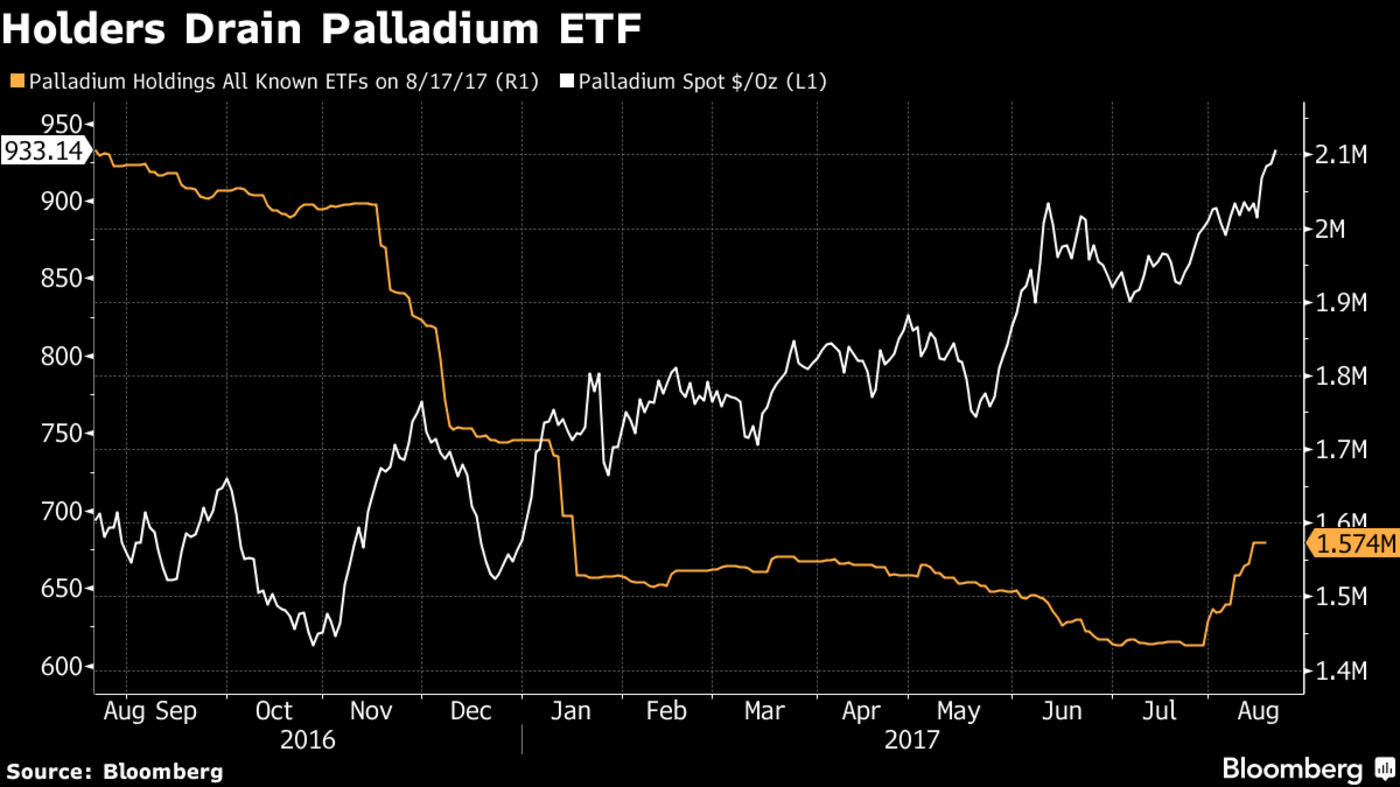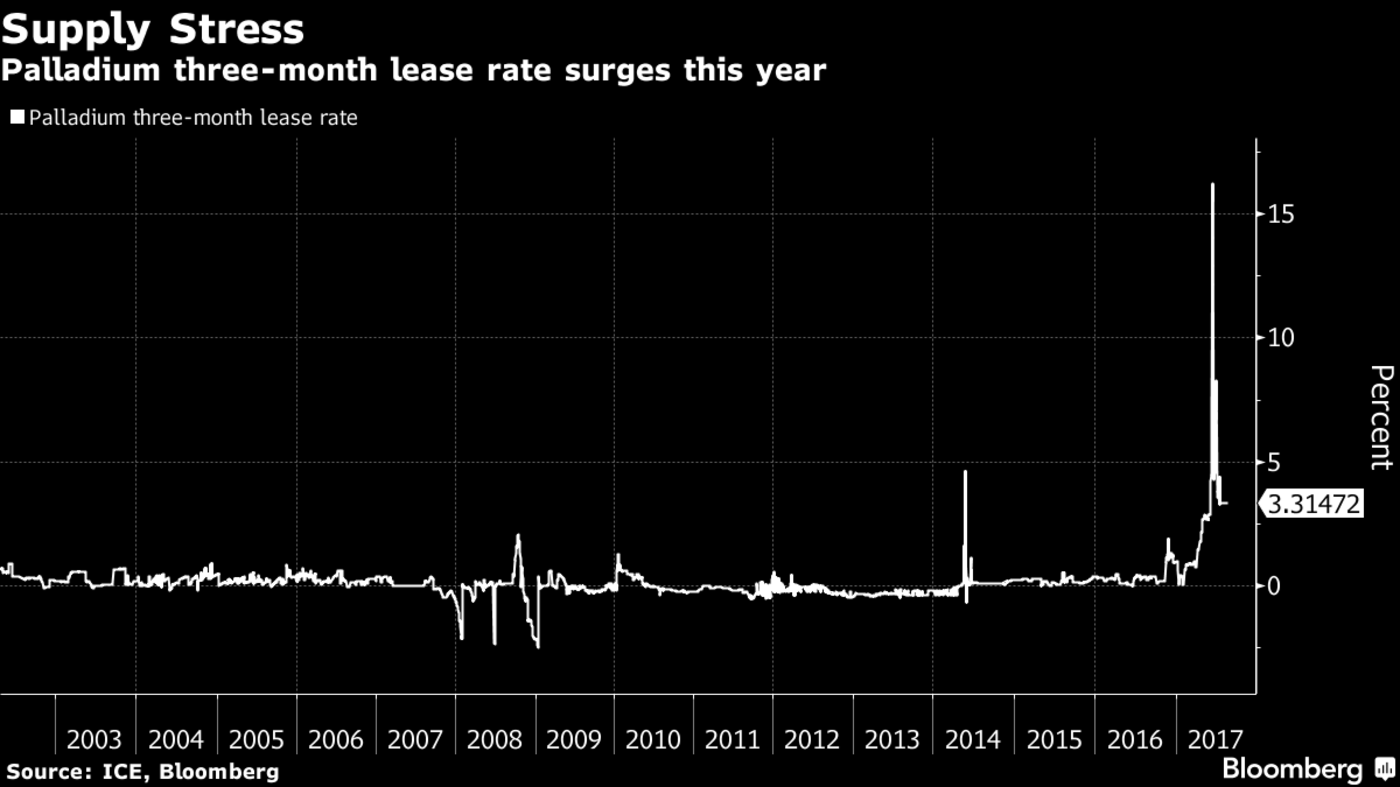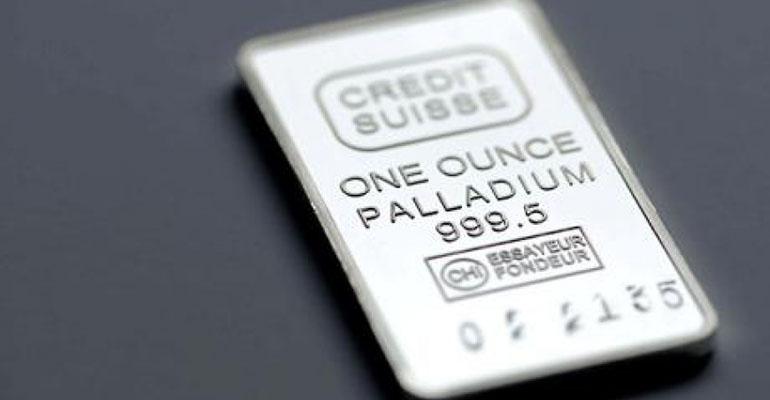By Carolina Wilson and Luzi Ann Javier
(Bloomberg) --Investors have made a fortune on palladium this year. So why are exchange-traded funds that track the precious metal hemorrhaging cash?
More than $49 million has left the two main U.S. and European palladium ETFs -- the ETFS Physical Palladium Shares and the ZKB Palladium fund -- or roughly 15 percent of assets through Aug. 21 this year, according to data compiled by Bloomberg. Across all ETFs, holdings of palladium have plunged from around 3.1 million ounces in 2014 to 1.6 million ounces today. And that’s while the metal has risen 38 percent this year to its highest price since 2001.
The explanation for the outflows lies in part in the scarcity of physical palladium and a robust borrowing market that has developed among users and speculators. Most ETFs that track stocks or bonds are fairly predictable in that flows typically correspond with performance. For funds that hold exotic assets like palladium however, quirks in the underlying market can often lead to more unpredictable patterns.
"This is different from the traditional ‘palladium is up, so let me buy it’ type sentiment," said Eric Balchunas, a Bloomberg Intelligence analyst. "There’s more intrigue here than usual."

Small, Opaque
To understand what’s happening, you’ve got to dig into the small, opaque world of the metal itself and the myriad ways sophisticated investors are using commodities ETFs. A platinum group metal, palladium has a variety of uses including in jewelry and dentistry, but a good deal of it ends up in automobiles to clean exhaust gases from gasoline engines.
Demand for such engines has soared in the wake of Volkswagen AG’s diesel emissions scandal, which has led to "tightness" in the market for physical palladium and contributed to scarcity, according to Michael Widmer, head of metals markets research at Bank of America Merrill Lynch in London.
Supply is set to trail demand by the most in at least seven years, according to researcher Metals Focus, while inventories in warehouses tracked by the New York Mercantile Exchange have shrunk by 45 percent this year.
The shortage of physical palladium is driving companies to seek out alternative ways of acquiring it. One way that has become increasingly popular is to pull together a bunch of shares of the ETF and redeem them with the issuer in exchange for an equivalent amount of the precious metal, minus costs.
"If the spot market is tight and it’s tough to get the metal, yes it makes sense to pay the extra cost of pulling supply from ETFs," said Ryan McKay, a commodity strategist at TD Securities in Toronto.
‘Swiss Army Knives’
It’s not unusual for institutional investors to use ETFs like this, and in other ways that go far beyond simple long-term allocation, said Balchunas, who likens the instruments to a Swiss army knife.
"In this case, the ETF is like a palladium warehouse," he said.
It’s not just companies in need of palladium that are tapping the ETF -- it’s also speculators like hedge funds, according to BofA’s Widmer. One quirk of palladium is that some users like oil companies prefer to lease instead of owning it outright, said Widmer.
In June, the cost to borrow palladium for one week climbed to as much as 25 percent as a result of weak supply, said David Jensen, founder of Jensen Strategic, a firm that offers strategic advisory services for the precious metals mining sector. Usually it hovers around 1 percent or less, he said. That’s created an opportunity for lenders, said BofA’s Widmer.

While there’s no harm in using ETFs like this, when investors rely too much on a fund at the expense of its underlying assets, it can distort the price, said Balchunas. If investors prefer to trade the ETF rather than in the primary market for palladium, a premium will arise in the fund’s price.
Premium Spike
The premium in the ETF Securities LLC fund tracking the metal, symbol PALL, spiked to 2.3 percent above its holdings on Aug. 16, according to data compiled by Bloomberg. That’s above its five-year average, but still not large enough to cause worry, said Balchunas.
Also, there are signs that the practice may be winding down. The amount of palladium held by all ETFs rebounded by around 100,000 ounces in August, according to data compiled by Bloomberg. "If you’ve come down 60 percent in terms of holdings, can there really be that much left?" said Jensen. "The remaining holders may actually be investors."
Indeed, some investors have continued to add cash, drawn in by palladium’s rally and the potential for further gains. The fund run by ETF Securities has gained 36 percent this year, while the Europe-listed Zuercher Kantonalbank Palladium ETF, ticker ZPAL, has surged 29 percent.
Andy Wester, a portfolio manager at Proficio Capital, bought the ETF Securities fund in September when the price was in the $60s, and now it’s $89.63. He’s been adding to his position ever since.
"PALL is our biggest bet right now," he said.
To contact the reporters on this story: Carolina Wilson in New York City at [email protected] ;Luzi Ann Javier in New York at [email protected] To contact the editors responsible for this story: Yakob Peterseil at [email protected] ;James Attwood at [email protected] Eric J. Weiner

